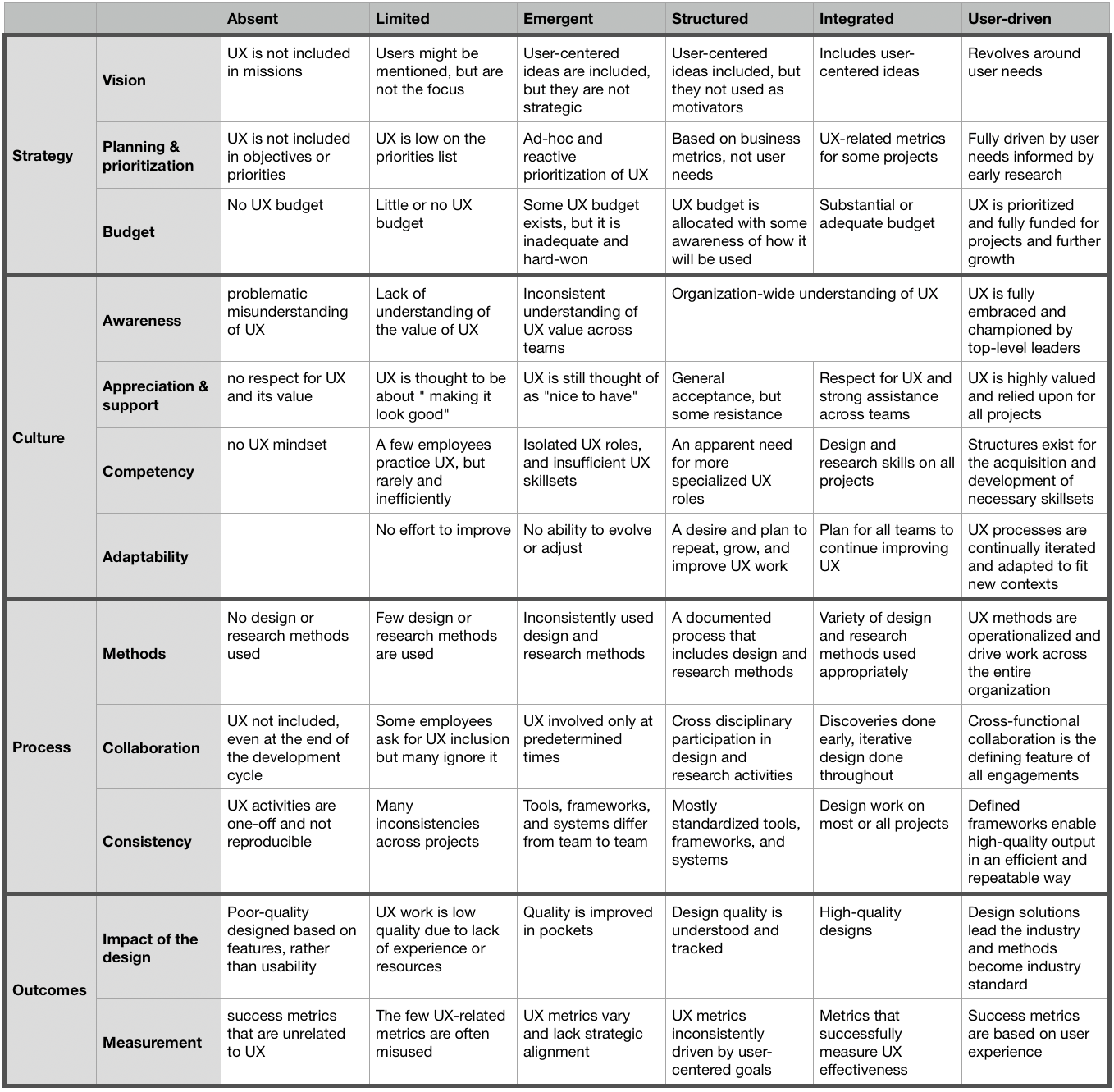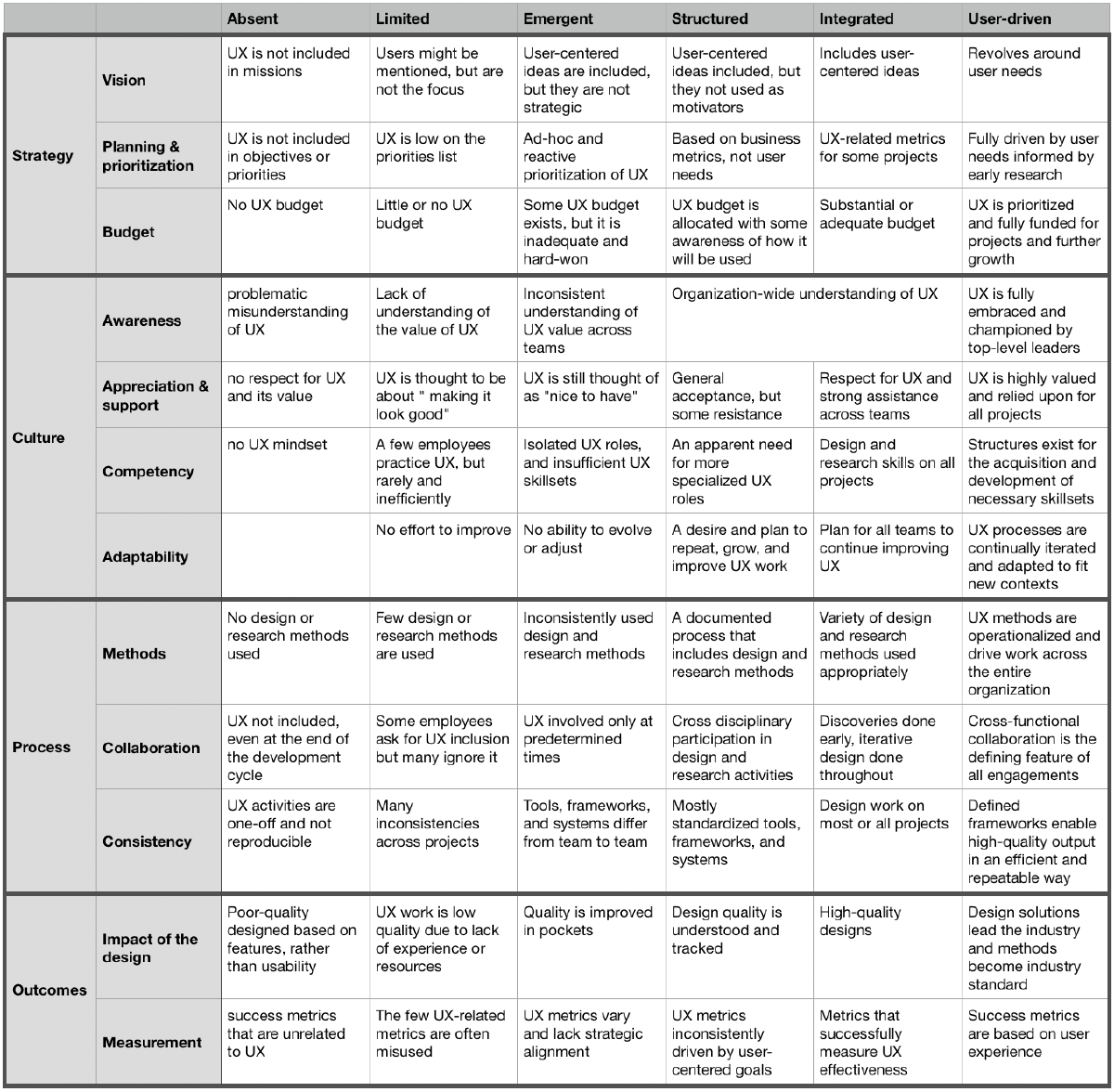As a Head of UX, I faced the challenge of setting the right direction for my team and organization. With numerous potential paths and solutions, I needed a clearer understanding of our current state and alignment with my team. The UX Maturity Model developed by Nielsen Norman Group provided the framework I needed to make well-guided decisions.
Assessing your organization’s UX maturity is crucial for design leaders. It provides a clear picture of where you stand, helps identify gaps, and guides strategic decision-making. This evaluation process informs your UX strategy and aligns your team’s perspectives and goals.
A data-driven approach to UX maturity
I decided to conduct a thorough evaluation to gain a comprehensive understanding of our UX maturity. Learning from past experiences where biased applications led to unactionable insights, I opted for a more structured and diverse approach.
Methodology: Structured interviews for deep insights
I used the UX Maturity Model1 as the foundation for creating a semi-structured interview guide. This approach allowed me to gather rich, qualitative data from my team members.

The evaluation process consisted of individual, two-hour interviews with each team member. We systematically went through the UX Maturity table, focusing on three key areas:
- Current state assessment: Team members reflected on our organization’s current maturity level for each aspect, justifying their choices.
- Future potential: They identified growth areas achievable within a year, outlining necessary conditions and actions for progress.
- Priority setting: Each member selected three critical focus areas for improving our organization’s UX maturity in the coming year.
For each aspect of the Maturity Model, I asked questions to gather insights about the current situation, the probable future in a year, and the first action to take.
Planning and prioritization
- Based on your experience, how are user needs integrated into our project planning and prioritization?
- How far could we improve in this area within one year, and what would that improvement look like?
- If you had a magic wand, what change would you immediately implement to enhance our planning process?
Awareness
- How would you describe the current understanding of user-centered design across different teams in our organization?
- What level of awareness could we achieve in a year if we focused on improvement?
- Imagine you’re giving a TED talk to our organization about the importance of user-centered design. What’s the one key message you’d want everyone to take away?
Methods
- What research and design methods are you currently using in your projects?
- How do you envision our toolkit evolving over the next year to serve our users and business goals better?
- If we were to run a workshop next month to elevate our design practices, what specific method or approach would you advocate for us to focus on?"
Results: Uncovering valuable insights
Focusing on my team’s perceptions gave me a realistic and nuanced understanding of our UX maturity. This approach yielded several key benefits:
- Enhanced communication: The evaluation process led to a more unified vocabulary across the team, improving our ability to articulate UX concepts and value to the broader organization.
- Aligned team perspective: Team members developed a shared understanding of our current status, fostering a more cohesive team culture and self-image.
- Actionable insights: I obtained detailed lists of issues, suggested solutions, and priorities directly from those on the front lines of our UX efforts.
- Organizational impact: The maturity evaluation inspired other teams to assess their domains, catalyzing improvements in leadership and communication across the organization.
A key insight from the evaluation was the varying levels of collaboration between UX practitioners and other teams. Teams that had worked closely with a UX team member for at least six months showed a structured level of collaboration, while others were still at limited or emerging stages. To address this gap and scale UX practices across the organization, we organized two-day hands-on training sessions on service design and design thinking.
This intensive workshop was open to members from various teams. Participants learned practical tools and methods for user-centered design, working on real project challenges during the sessions. The impact was noticeable: teams participating in the training began incorporating user research and design thinking techniques into their daily work.
While we didn’t track specific metrics, we observed a qualitative improvement in cross-team collaboration and a greater appreciation for user-centered approaches across the organization. Teams began proactively seeking UX input earlier in their processes, leading to more cohesive and user-friendly solutions.
This evaluation served as the foundation for developing our UX area strategy. It gave me a clear understanding of our team’s perception of the organization’s UX maturity and detailed suggestions for improvement.
By leveraging the UX Maturity Model and conducting thorough evaluations, I gained insights into making informed decisions, aligning my team, and driving meaningful improvements in my organization’s UX practices. This data-driven approach will empower you to lead confidently and precisely , ensuring UX strategy is impactful and well-grounded in organizational realities.
Kara Pernice, Sarah Gibbons, Kate Moran, and Kathryn Whitenton, “The 6 levels of UX Maturity,” Nielsen Norman Group, January 24, 2024, https://www.nngroup.com/articles/ux-maturity-model/ ↩︎

